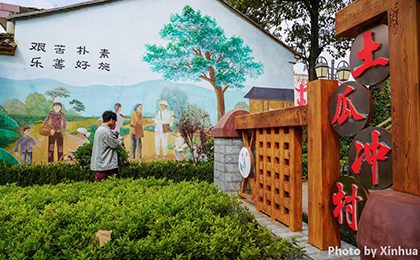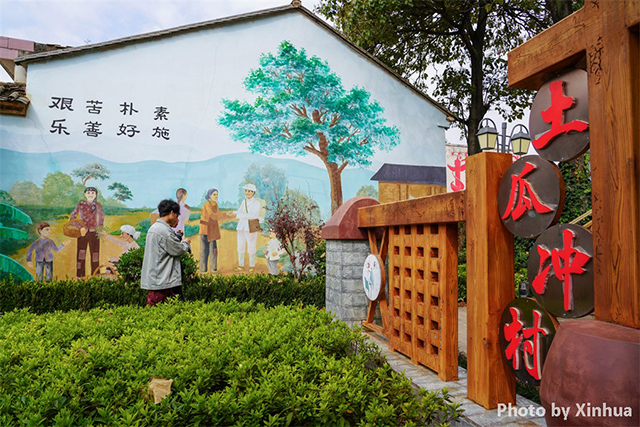



▲ People visit Tuguachong village in Qujing city, Southwest China's Yunnan province. [Xinhua]
8. Building Livable and Workable Beautiful Villages to Enhance Farmers’ Well-being.
8.1 Promoting infrastructure upgrades.
Improve road network accessibility by upgrading rural road backbone networks and extending basic networks. Strengthen water supply security by advancing urban-rural integrated water supply and scaling up centralized water supply, implementing standardized construction and renovation of small-scale water supply projects, and enhancing medium and small-scale water source protection projects. Implement water quality improvement actions. Optimize energy supply and develop clean energy. Upgrading the quality and safety of rural housing and promoting the construction of modern and livable rural homes.
8.2 Continuously improving living environments.
Implement rural construction initiatives in a tailored and practical manner. Advance the “toilet revolution” in rural areas, improving rural toilet construction and management systems while integrating this effort with domestic sewage treatment. Classify and manage domestic sewage treatment to eliminate large-scale black and odorous water bodies. Enhance domestic waste management by promoting waste classification and reduction at the source, localized treatment, and resource utilization while improving collection and disposal systems. Strengthen the disposal capacity for toxic and hazardous waste. Upgrade the appearance of villages by carrying out rural greening and beautification actions and village cleanliness actions.
8.3 Steadily improving basic public services.
Enhance rural education quality by optimizing county-level educational layouts, improving basic conditions for compulsory education, promoting preschool and special education, and intensifying teacher training. Promote healthy rural development by improving healthcare service systems, ensuring basic medical insurance, critical illness insurance, and medical assistance, and building public fitness facilities based on local conditions. Improve basic livelihood security by developing elderly care service networks, advancing the construction of homes for the aged and other facilities, and actively promoting mutual care for the elderly. Implement mechanisms for determining urban and rural residents’ basic pension benefits and ensuring regular adjustments to basic pensions.
8.4 Improving rural community service facilities.
Plan and allocate rural community service facilities scientifically and reasonably to improve service conditions. Revitalize and repurpose idle facilities for community services. Enhance the efficiency of rural community service facilities and encourage social organizations, cooperatives, and community groups to participate in construction, management, and service provision.
8.5 Accelerating digital village development.
Improve information infrastructure by implementing smart radio and television projects in rural areas and advancing digital and intelligent infrastructure upgrades. Build a comprehensive information service system. Digitize management and services by expanding “Internet+” and “Smart Radio and Television+” government services to the grassroots levels. Strengthen the digital development of education, healthcare, and cultural initiatives in rural areas. Continue implementing digital village development actions.
8.6 Optimizing rural planning and construction.
Develop village planning based on local conditions, prioritize projects that enhance both living standards and economic activities, and encourage farmer participation in planning and management. Make full use of existing facilities and prohibit the use of public funds for landscape projects. Conduct evaluations of rural construction. Establish and improve mechanisms for the operation and maintenance of rural public infrastructure, ensuring that construction and maintenance mechanisms are implemented simultaneously. Where feasible, promote integrated urban-rural maintenance.
9. Deepening Agricultural and Rural Reforms to Stimulate Rural Development Vitality.
9.1 Consolidating and improving the basic rural management system
Gradually extend the second round of land contracting for another 30 years upon expiration. Deepen the separation of ownership, contracting rights, and operational rights for farmland to promote appropriately scaled agricultural operations. Improve farmland contract management systems. Establish a modern, multi-dimensional agricultural management system based on household farming, supported by cooperative and joint operations, and enhanced by socialized services, fostering cooperative farming among farmers. Encourage small farmers to contribute land management rights to new agricultural business entities. Develop new forms of rural collective economy and grant farmers more extensive property rights. Standardize rural collective economic organizations, manage their operations efficiently, regulate rural property transactions, and strictly control collective business risks and debt levels.
9.2 Deepening the reform of the rural land system.
Accelerate the completion of registration and certification of homesteads under a unified property rights system for houses and land, allowing farmers to legally own housing that can be activated through leasing, shareholding, cooperation, and other methods. Progressively advance the reform of allowing rural collective operational construction land to enter the market, prioritizing land use for rural revitalization. Strengthen the guarantee of land for rural development by allocating at least 5% of newly added construction land quotas in provincial land-use plans for key rural industries and projects. County and township-level territorial plans should coordinate agricultural and rural development land needs. Reclaimed construction land quotas can be incorporated into annual land-use plans.
9.3 Establishing a diversified rural revitalization investment guarantee mechanism.
Enhance financial support by prioritizing agriculture and rural development in general public budget allocations and ensuring a greater share of land transfer revenue is allocated to rural development. Improve financial services by establishing mechanisms for large and medium-sized banks to serve agriculture, rural areas, and farmers. Strengthening the role of small rural financial institutions in supporting small farmers and rural businesses, and accelerating rural credit cooperative reforms. Develop rural digital inclusive finance, improve the rural credit system, and expand multi-level agricultural insurance. Support the lawful establishment of rural revitalization funds through market mechanisms. Encourage and regulate private investment in agriculture and rural development. Ensure that rural revitalization investment is carried out prudently, avoiding the risks of new local government debt.
9.4 Steadily advancing key rural reform tasks.
Deepen comprehensive reforms of supply and marketing cooperatives. Promote the corporatization of state-owned farms and the commercialization of farm enterprises while strengthening cooperation between farms and local communities. Improve systems for collective forest rights, state-owned forest farms, grassland contracting, and rural collective land acquisition. Advance comprehensive reform of agricultural water prices. Leverage the exemplary role of national rural reform experimental zones, national urban-rural integrated development experimental zones, and pilot projects for comprehensive rural reform to drive further reforms.
Source:<https://www.gov.cn/zhengce/202501/content_7000499.htm>
Editor & Translator: GUO Xinxin